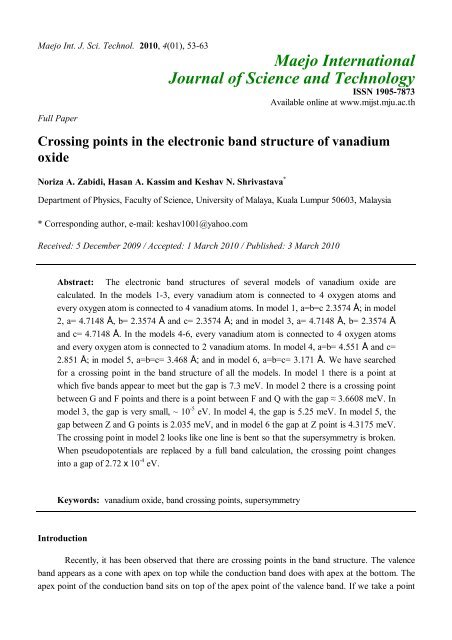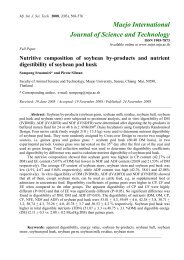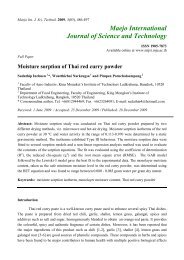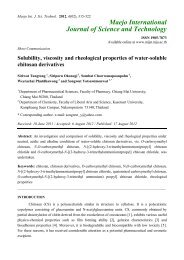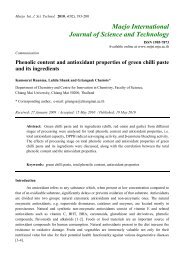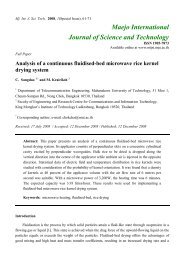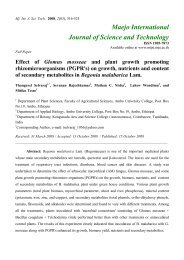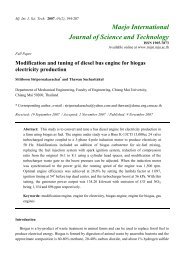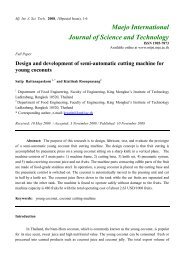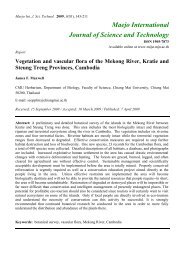Crossing points in the electronic band structure of vanadium oxide
Crossing points in the electronic band structure of vanadium oxide
Crossing points in the electronic band structure of vanadium oxide
You also want an ePaper? Increase the reach of your titles
YUMPU automatically turns print PDFs into web optimized ePapers that Google loves.
Maejo Int. J. Sci. Technol. 2010, 4(01), 53-63Full PaperMaejo InternationalJournal <strong>of</strong> Science and TechnologyISSN 1905-7873Available onl<strong>in</strong>e at www.mijst.mju.ac.th<strong>Cross<strong>in</strong>g</strong> <strong>po<strong>in</strong>ts</strong> <strong>in</strong> <strong>the</strong> <strong>electronic</strong> <strong>band</strong> <strong>structure</strong> <strong>of</strong> <strong>vanadium</strong><strong>oxide</strong>Noriza A. Zabidi, Hasan A. Kassim and Keshav N. Shrivastava *Department <strong>of</strong> Physics, Faculty <strong>of</strong> Science, University <strong>of</strong> Malaya, Kuala Lumpur 50603, Malaysia* Correspond<strong>in</strong>g author, e-mail: keshav1001@yahoo.comReceived: 5 December 2009 / Accepted: 1 March 2010 / Published: 3 March 2010Abstract: The <strong>electronic</strong> <strong>band</strong> <strong>structure</strong>s <strong>of</strong> several models <strong>of</strong> <strong>vanadium</strong> <strong>oxide</strong> arecalculated. In <strong>the</strong> models 1-3, every <strong>vanadium</strong> atom is connected to 4 oxygen atoms andevery oxygen atom is connected to 4 <strong>vanadium</strong> atoms. In model 1, a=b=c 2.3574 Å; <strong>in</strong> model2, a= 4.7148 Å, b= 2.3574 Å and c= 2.3574 Å; and <strong>in</strong> model 3, a= 4.7148 Å, b= 2.3574 Åand c= 4.7148 Å. In <strong>the</strong> models 4-6, every <strong>vanadium</strong> atom is connected to 4 oxygen atomsand every oxygen atom is connected to 2 <strong>vanadium</strong> atoms. In model 4, a=b= 4.551 Å and c=2.851 Å; <strong>in</strong> model 5, a=b=c= 3.468 Å; and <strong>in</strong> model 6, a=b=c= 3.171 Å. We have searchedfor a cross<strong>in</strong>g po<strong>in</strong>t <strong>in</strong> <strong>the</strong> <strong>band</strong> <strong>structure</strong> <strong>of</strong> all <strong>the</strong> models. In model 1 <strong>the</strong>re is a po<strong>in</strong>t atwhich five <strong>band</strong>s appear to meet but <strong>the</strong> gap is 7.3 meV. In model 2 <strong>the</strong>re is a cross<strong>in</strong>g po<strong>in</strong>tbetween G and F <strong>po<strong>in</strong>ts</strong> and <strong>the</strong>re is a po<strong>in</strong>t between F and Q with <strong>the</strong> gap ≈ 3.6608 meV. Inmodel 3, <strong>the</strong> gap is very small, ~ 10 -5 eV. In model 4, <strong>the</strong> gap is 5.25 meV. In model 5, <strong>the</strong>gap between Z and G <strong>po<strong>in</strong>ts</strong> is 2.035 meV, and <strong>in</strong> model 6 <strong>the</strong> gap at Z po<strong>in</strong>t is 4.3175 meV.The cross<strong>in</strong>g po<strong>in</strong>t <strong>in</strong> model 2 looks like one l<strong>in</strong>e is bent so that <strong>the</strong> supersymmetry is broken.When pseudopotentials are replaced by a full <strong>band</strong> calculation, <strong>the</strong> cross<strong>in</strong>g po<strong>in</strong>t changes<strong>in</strong>to a gap <strong>of</strong> 2.72 x 10 -4 eV.Keywords: <strong>vanadium</strong> <strong>oxide</strong>, <strong>band</strong> cross<strong>in</strong>g <strong>po<strong>in</strong>ts</strong>, supersymmetryIntroductionRecently, it has been observed that <strong>the</strong>re are cross<strong>in</strong>g <strong>po<strong>in</strong>ts</strong> <strong>in</strong> <strong>the</strong> <strong>band</strong> <strong>structure</strong>. The valence<strong>band</strong> appears as a cone with apex on top while <strong>the</strong> conduction <strong>band</strong> does with apex at <strong>the</strong> bottom. Theapex po<strong>in</strong>t <strong>of</strong> <strong>the</strong> conduction <strong>band</strong> sits on top <strong>of</strong> <strong>the</strong> apex po<strong>in</strong>t <strong>of</strong> <strong>the</strong> valence <strong>band</strong>. If we take a po<strong>in</strong>t
Maejo Int. J. Sci. Technol. 2010, 4(01), 53-6354on <strong>the</strong> cone <strong>of</strong> <strong>the</strong> conduction <strong>band</strong> with energy E, <strong>the</strong>n for <strong>the</strong> same wave vector, <strong>in</strong> <strong>the</strong> valence <strong>band</strong><strong>the</strong>re is a po<strong>in</strong>t with energy –E. When <strong>the</strong> magnitude <strong>of</strong> <strong>the</strong> energy E <strong>in</strong> <strong>the</strong> conduction <strong>band</strong> is equal to<strong>the</strong> magnitude <strong>of</strong> <strong>the</strong> energy –E <strong>in</strong> <strong>the</strong> valence <strong>band</strong>, <strong>the</strong>re is supersymmetry; o<strong>the</strong>rwise <strong>the</strong>supersymmetry is broken. In <strong>the</strong> <strong>the</strong>ory <strong>of</strong> relativity, <strong>the</strong> energy <strong>of</strong> a particle <strong>of</strong> momentum p and massm is given by ± (c 2 p 2 + m 2 c 4 ) 1/2 where <strong>the</strong> magnitude <strong>of</strong> <strong>the</strong> energy with positive sign is exactly equal tothat with negative sign. This is called <strong>the</strong> supersymmetry. In <strong>the</strong> Dirac equation, <strong>the</strong> negative energystates are associated with a particle <strong>of</strong> positive charge called <strong>the</strong> positron and <strong>the</strong> positive energysolutions are associated with <strong>the</strong> electron. The electron energy solutions found <strong>in</strong> <strong>the</strong> non-relativisticSchröd<strong>in</strong>ger equation may be mapped to that <strong>of</strong> <strong>the</strong> Dirac equation. The two-energy solutions <strong>in</strong> ± (c 2 p 2+ m 2 c 4 ) 1/2 never cross but it is possible to select a po<strong>in</strong>t <strong>in</strong> <strong>the</strong> middle <strong>of</strong> <strong>the</strong> two solutions which isnamed as <strong>the</strong> “Dirac po<strong>in</strong>t” [1, 2]. The geometric average <strong>of</strong> <strong>the</strong> two energies <strong>in</strong> which one is a constant and<strong>the</strong> o<strong>the</strong>r varies as n will vary as <strong>the</strong> square root <strong>of</strong> n. For zero mass, mc 2 term is zero and <strong>the</strong> c 2 p 2 term variesl<strong>in</strong>early as a function <strong>of</strong> momentum. This l<strong>in</strong>ear dependence with both signs forms a cross<strong>in</strong>g po<strong>in</strong>t called <strong>the</strong>"Dirac po<strong>in</strong>t" as shown <strong>in</strong> Figure 1.Figure 1. The cross<strong>in</strong>g po<strong>in</strong>t <strong>of</strong> <strong>the</strong> two dash l<strong>in</strong>es becomes a cone when visualised <strong>in</strong> three dimensions. Thecross<strong>in</strong>g po<strong>in</strong>t can be at <strong>the</strong> top <strong>of</strong> one cone and at <strong>the</strong> bottom <strong>of</strong> ano<strong>the</strong>r cone and hence matches with <strong>the</strong> apexpo<strong>in</strong>t. The position <strong>of</strong> Fermi energy can be fixed from an <strong>in</strong>dependent calculation [2].The energy mc 2 <strong>in</strong> <strong>the</strong> Dirac equation is <strong>of</strong> <strong>the</strong> order <strong>of</strong> 0.5 x 10 6 eV, which is very largecompared with <strong>the</strong> energies ≈ 10 -3 eV found <strong>in</strong> <strong>the</strong> semiconductors. If <strong>the</strong>re is a po<strong>in</strong>t <strong>in</strong> <strong>the</strong> centre <strong>of</strong><strong>the</strong> conduction and valence <strong>band</strong>s it should be called <strong>the</strong> Schröd<strong>in</strong>ger po<strong>in</strong>t. The object <strong>of</strong> <strong>the</strong> presentstudy is to look for cross<strong>in</strong>g <strong>po<strong>in</strong>ts</strong> <strong>in</strong> <strong>the</strong> electron energy <strong>band</strong>s obta<strong>in</strong>ed from <strong>the</strong> solutions <strong>of</strong> <strong>the</strong>density-functional <strong>the</strong>ory. In a calculation <strong>of</strong> <strong>band</strong> <strong>structure</strong> <strong>of</strong> a monolayer <strong>of</strong> carbon atoms, <strong>the</strong>cross<strong>in</strong>g po<strong>in</strong>t with <strong>the</strong> supersymmetry was searched [3]. In a recent study <strong>of</strong> <strong>the</strong> cross<strong>in</strong>g <strong>po<strong>in</strong>ts</strong> and<strong>band</strong> bend<strong>in</strong>g <strong>in</strong> TiO 2 /VO 2 nano<strong>structure</strong>s, semi-Dirac <strong>po<strong>in</strong>ts</strong> have been discussed [4]. The compounds<strong>of</strong> <strong>vanadium</strong> show several different valencies. In VO 2 , <strong>the</strong> valency <strong>of</strong> <strong>vanadium</strong> is 4. The VO 2 showsseveral phases as a function <strong>of</strong> temperature and pressure. For T > 340 K it has a pseudo R phase. For<strong>the</strong> pressure larger than 200 bar and temperature less than 340 K, <strong>the</strong> phase is called M 1 , and for T
Maejo Int. J. Sci. Technol. 2010, 4(01), 53-6355called M 2 [5]. There is a Peierls distortion so that <strong>the</strong> <strong>vanadium</strong> atoms occur <strong>in</strong> pairs [6]. The <strong>electronic</strong>configuration <strong>of</strong> <strong>vanadium</strong> is 3d 3 4s 2 . In <strong>the</strong> tetravalent position, it is 3d 1 . Hence, two atoms form a sp<strong>in</strong>triplet. The experimental optical gap is 0.6 eV [7] but <strong>the</strong> calculated value is -0.04 eV [8]. Hence, itwill be <strong>of</strong> <strong>in</strong>terest to calculate <strong>the</strong> gap energy. The compounds V 2n O 5n-2 are known as Wadsley phaseand V n O 2n-1 are called Magneli phase. It is clear that many phases with different valencies occur and<strong>the</strong>re are phase transitions as a function <strong>of</strong> pressure. The Raman spectra <strong>of</strong> VO 2 show a phase transitionat a pressure <strong>of</strong> 12 GPa. It has been shown that <strong>the</strong> metal-<strong>in</strong>sulator transition and <strong>the</strong> <strong>electronic</strong><strong>structure</strong> are correlated [9]. The M 1 phase <strong>of</strong> VO 2 is charge ordered [10]. There are a series <strong>of</strong>avalanches which depend on <strong>the</strong> particle size before <strong>the</strong> transition is completed [11]. A po<strong>in</strong>t-ion modelhas been described by Nakatsugawa and Iguchi [12]. The early ideas <strong>of</strong> <strong>the</strong> metal-<strong>in</strong>sulator transitionwere given by Zylbersztejn and Mott [13].In <strong>the</strong> present work, we have made six models <strong>of</strong> <strong>vanadium</strong> <strong>oxide</strong>. Out <strong>of</strong> <strong>the</strong>se six models, threehave <strong>vanadium</strong> valency equal to 2 and <strong>the</strong> rema<strong>in</strong><strong>in</strong>g 3 have <strong>vanadium</strong> valency equal to 4. In all <strong>of</strong> <strong>the</strong>cases we optimise <strong>the</strong> <strong>structure</strong>s and calculate <strong>the</strong> <strong>band</strong> stuctures to look for cross<strong>in</strong>g <strong>po<strong>in</strong>ts</strong>. We f<strong>in</strong>d across<strong>in</strong>g po<strong>in</strong>t only when pseudopotentials are used <strong>in</strong> Castep programme. In <strong>the</strong> full calculation, tak<strong>in</strong>g<strong>in</strong>to account all <strong>of</strong> <strong>the</strong> electrons, cross<strong>in</strong>g disappears and gaps appear. We report all <strong>of</strong> <strong>the</strong> gaps found.The models are calculated us<strong>in</strong>g sp<strong>in</strong> unpolarised orbital for both Castep and DMol3 programmes. Wetake <strong>the</strong> P1 space group for all <strong>of</strong> <strong>the</strong> models.Materials and MethodsThe <strong>electronic</strong> <strong>band</strong> <strong>structure</strong> is calculated by us<strong>in</strong>g <strong>the</strong> density-functional <strong>the</strong>ory which is anapproximation <strong>of</strong> <strong>the</strong> Schröd<strong>in</strong>ger equation. The potential energy is expressed <strong>in</strong> <strong>the</strong> form <strong>of</strong> electrondensity and <strong>the</strong>n <strong>the</strong> energy is m<strong>in</strong>imised to obta<strong>in</strong> <strong>the</strong> Kohn-Sham equation [14, 15], which can besolved <strong>in</strong> local density approximation (LDA) as well as <strong>in</strong> <strong>the</strong> generalised gradient approximation(GGA). The actual atoms connect by exchange and correlation <strong>in</strong>tegrals so <strong>the</strong> l<strong>in</strong>ear GGA is quiteapproximate but may be compared with <strong>the</strong> LDA. We calculate <strong>the</strong> <strong>band</strong> <strong>structure</strong> by us<strong>in</strong>g <strong>the</strong> DMol3(all electrons) as well as <strong>the</strong> Castep (pseudopotentials) programmes [16]. We present <strong>the</strong> results <strong>of</strong> <strong>the</strong>calculation <strong>of</strong> <strong>the</strong> gap energy <strong>in</strong> both approximations. All <strong>of</strong> <strong>the</strong> results are obta<strong>in</strong>ed <strong>in</strong> LDA andunpolarised orbitals are used. Both <strong>the</strong> Castep and <strong>the</strong> DMol3 were k<strong>in</strong>dly provided by AccelrysS<strong>of</strong>tware Inc, San Diego, CA. The geometry and <strong>the</strong> unit cell sizes (a, b and c) are calculated bym<strong>in</strong>imis<strong>in</strong>g <strong>the</strong> energy <strong>of</strong> <strong>the</strong> Schröd<strong>in</strong>ger equation for each model.Results and DiscussionModels <strong>of</strong> <strong>vanadium</strong> <strong>oxide</strong>Model 1: VO. In this model, V atom is coord<strong>in</strong>ated with 4 oxygen atoms and every oxygen atom iscoord<strong>in</strong>ated with 4 <strong>vanadium</strong> atoms. The V-O distance is 1.667Å and a=b=c=2.3574Å. The coord<strong>in</strong>ates<strong>of</strong> k <strong>po<strong>in</strong>ts</strong> are G (0, 0, 0), F (0, 0.5, 0), Q (0, 0.5, 0.5) and Z (0, 0, 0.5). The model is shown <strong>in</strong> Figure2 and <strong>the</strong> calculated <strong>band</strong> <strong>structure</strong> along with <strong>the</strong> density <strong>of</strong> states (DOS) is shown <strong>in</strong> Figure 3, which
Maejo Int. J. Sci. Technol. 2010, 4(01), 53-6356also identifies <strong>the</strong> various zone <strong>po<strong>in</strong>ts</strong>. The Fermi energy, <strong>the</strong> b<strong>in</strong>d<strong>in</strong>g energy and <strong>the</strong> gaps at <strong>the</strong> k<strong>po<strong>in</strong>ts</strong> are given <strong>in</strong> Table 1.Figure 2. Model 1: The central V atom is connected to 4 oxygen atoms.Figure 3. The <strong>band</strong> <strong>structure</strong> and <strong>the</strong> DOS <strong>of</strong> model 1Table 1. The Fermi energy, <strong>the</strong> b<strong>in</strong>d<strong>in</strong>g energy and <strong>the</strong> energy gap at various k <strong>po<strong>in</strong>ts</strong>Model 1 Model 2 Model 3 Model 4 Model 5 Model 6Fermi energy (eV) 7.2234 7.0312 7.1722 6.6447 6.9399 6.8908B<strong>in</strong>d. energy (eV) 10.931 21.8223 43.6524 19.8832 20.4224 17.4416Energy gap (eV) G 6.1907 4.2791 0.5851 0.9252 0.8844 0.1361F 1.1565 0.8028 0.7891 0.7551 1.2586 1.5579Q 11.7012 5.4152Z 6.1907 2.4899 2.97290.2177,1.1905 1.83 2.5035 1.45580.1905,2.0953 0.9456 1.1837Model 2: V 2 O 2 . In this model every <strong>vanadium</strong> atom is coord<strong>in</strong>ated to 4 oxygen atoms and everyoxygen atom is also coord<strong>in</strong>ated to 4 <strong>vanadium</strong> atoms. The layer<strong>in</strong>g <strong>of</strong> atoms is such that b=c=2.3574Å
Maejo Int. J. Sci. Technol. 2010, 4(01), 53-6358Figure 7. The <strong>band</strong> <strong>structure</strong> and <strong>the</strong> DOS <strong>of</strong> model 3Model 4: VO 2 . In this model shown <strong>in</strong> Figure 8, every <strong>vanadium</strong> atom is connected to 4 oxygenatoms but every oxygen atom is connected to only 2 <strong>vanadium</strong> atoms with <strong>the</strong> V-O distance <strong>of</strong> 1.895Å.The unit cell parameters are a=b=4.551Å and c=2.851Å. The calculated <strong>band</strong> <strong>structure</strong> and <strong>the</strong> DOS aregiven <strong>in</strong> Figure 9, and <strong>the</strong> gap energies are given <strong>in</strong> Table 1.Figure 8. Model 4: One <strong>vanadium</strong> atom is connected to 4 oxygen atoms and one oxygen atom isconnected to 2 <strong>vanadium</strong> atoms.Figure 9. The <strong>band</strong> <strong>structure</strong> and <strong>the</strong> DOS <strong>of</strong> model 4
Maejo Int. J. Sci. Technol. 2010, 4(01), 53-6359Model 5: VO 2 . This model is shown <strong>in</strong> Figure 10. It has <strong>the</strong> unit cell <strong>of</strong> a=b=c=3.468Å. The V-Odistance is 1.734Å and <strong>the</strong> <strong>band</strong> <strong>structure</strong> along with <strong>the</strong> DOS is shown <strong>in</strong> Figure 11. The calculated gapenergies are given <strong>in</strong> Table 1.Figure 10. Model 5: The cubic model <strong>of</strong> <strong>vanadium</strong> <strong>oxide</strong>Figure 11. The <strong>band</strong> <strong>structure</strong> and <strong>the</strong> DOS <strong>of</strong> model 5Model 6: VO 2 . In this model <strong>the</strong> atoms are rearranged similar to those <strong>in</strong> model 5. The V-Odistance is slightly elongated to 1.831Å and a=b=c=3.171Å. The model is shown <strong>in</strong> Figure 12 and <strong>the</strong><strong>band</strong> <strong>structure</strong> along with <strong>the</strong> DOS is given <strong>in</strong> Figure 13. The calculated gap energies are given <strong>in</strong> Table1.Figure 12. Model 6 <strong>of</strong> <strong>vanadium</strong> <strong>oxide</strong> (VO 2 )
Maejo Int. J. Sci. Technol. 2010, 4(01), 53-6360Figure 13. The <strong>band</strong> <strong>structure</strong> and <strong>the</strong> DOS <strong>of</strong> model 6<strong>Cross<strong>in</strong>g</strong> <strong>po<strong>in</strong>ts</strong>When we magnify all <strong>the</strong> <strong>band</strong> <strong>structure</strong>s to search for cross<strong>in</strong>g <strong>po<strong>in</strong>ts</strong>, we f<strong>in</strong>d that all cross<strong>in</strong>g<strong>po<strong>in</strong>ts</strong> actually open a gap except <strong>in</strong> model 2 <strong>in</strong> Castep (pseudopotentials). When <strong>the</strong> program takes <strong>in</strong>toaccount all <strong>the</strong> orbitals, <strong>the</strong>se cross<strong>in</strong>gs also change <strong>in</strong>to a small gap. These small gaps are shown <strong>in</strong>Table 2. It can be observed that Castep gives zero value for <strong>the</strong> gap, whereas DMol3 gives a smallvalue, 2.72 x 10 -4 eV, <strong>in</strong> model 2 <strong>in</strong> between G and F <strong>po<strong>in</strong>ts</strong>. This is due to <strong>the</strong> <strong>in</strong>teractions betweenelectrons. Thus, <strong>the</strong> pseudopotential method does not see <strong>the</strong> small gaps at some places which can beseen when all <strong>of</strong> <strong>the</strong> electrons are considered properly.SupersymmetryIn Figure 14, <strong>the</strong> cross<strong>in</strong>g po<strong>in</strong>t obta<strong>in</strong>ed from <strong>the</strong> Castep calculation <strong>of</strong> model 2 is shown. Infact when all <strong>of</strong> <strong>the</strong> electrons are taken <strong>in</strong>to account, this cross<strong>in</strong>g po<strong>in</strong>t opens up a gap <strong>of</strong> about 2.72 x10 -4 eV. If we look at <strong>the</strong> cross carefully we f<strong>in</strong>d that it is not a cross <strong>of</strong> two l<strong>in</strong>es but a confluence po<strong>in</strong>t<strong>of</strong> four l<strong>in</strong>es.Figure 14. <strong>Cross<strong>in</strong>g</strong> po<strong>in</strong>t <strong>in</strong> <strong>the</strong> space between G and F <strong>po<strong>in</strong>ts</strong> at about 0.3 eV
Maejo Int. J. Sci. Technol. 2010, 4(01), 53-6361Table 2. Small energy gaps between two k <strong>po<strong>in</strong>ts</strong> or at a k po<strong>in</strong>t <strong>in</strong> eVModel Castep (pseudopotentials) DMol3 (all electrons)Model 1 7.3 x 10 -3 (G-F) 17.2 x10 -2 (G-F)Model 2Model 30.00 (G-F)3.66 x 10 -3 (F-Q)7.35 x 10 -3 (G-F)2.88 x 10 -5 (Q)6.25 x 10 -5 (Q)2.72 x 10 -4 (G-F)18.12 x 10 -3 (F-Q)1.53 x 10 -3 (F-Q)10.3 x 10 -3 (G-F)34.5 x 10 -3 (F-Q)Model 4 5.25 x 10 -3 (F) 32.5 x 10 -3 (F-Q)Model 5Model 69.48 x 10 -3 (G-F)2.04 x 10 -3 (Z-G)12.43 x 10 -3 (Z)4.32 x 10 -3 (Z)10.43 x 10 -3 (Z-G)10.23 x 10 -3 (Z-G)4.38 x 10 -3 (Z-G)13.03 x 10 -3 (G-F)11.05 x 10 -3 (G-F)32.27 x 10 -3 (G-F)3.62 x 10 -4 (Z-G)9.36 x 10 -3 (Z-G)11.43 x 10 -3 (Z)When we draw a horizontal l<strong>in</strong>e and look for <strong>the</strong> positive solutions above <strong>the</strong> l<strong>in</strong>e and compare<strong>the</strong>m with those below <strong>the</strong> horizontal l<strong>in</strong>e, <strong>the</strong> supersymmetry is not found. The expanded version <strong>of</strong> <strong>the</strong>Castep <strong>band</strong> <strong>structure</strong> <strong>of</strong> model 3 shown <strong>in</strong> Figure 15 also shows gaps between G and F <strong>po<strong>in</strong>ts</strong> which <strong>in</strong>DMol3 show gaps.Figure 15. The expanded version <strong>of</strong> <strong>band</strong> <strong>structure</strong> <strong>of</strong> model 3
Maejo Int. J. Sci. Technol. 2010, 4(01), 53-6362ConclusionsWe have studied 6 different models <strong>of</strong> <strong>vanadium</strong> <strong>oxide</strong> and have calculated <strong>the</strong> gaps <strong>in</strong> all <strong>of</strong> <strong>the</strong>cases. In models 1-3, <strong>the</strong> valency <strong>of</strong> <strong>vanadium</strong> is two so that we see <strong>the</strong> alignment <strong>of</strong> V 2+ ions, whereas<strong>in</strong> models 4-6, <strong>vanadium</strong> has a valency <strong>of</strong> 4, thus show<strong>in</strong>g <strong>the</strong> order<strong>in</strong>g <strong>of</strong> V 4+ ions. We have searchedfor <strong>the</strong> cross<strong>in</strong>g <strong>po<strong>in</strong>ts</strong> by us<strong>in</strong>g two valencies and six models but discovered “confluence <strong>po<strong>in</strong>ts</strong>.” Thecross<strong>in</strong>g may be called <strong>the</strong> “Dirac po<strong>in</strong>t.” However, our calculation is non-relativistic and hence“Schröd<strong>in</strong>ger po<strong>in</strong>t” is a more appropriate term<strong>in</strong>ology for <strong>the</strong> cross<strong>in</strong>g po<strong>in</strong>t.AcknowledgementsWe are grateful to <strong>the</strong> University <strong>of</strong> Malaya for support<strong>in</strong>g this work. The FundamentalResearch Grants Scheme (FRGS) <strong>of</strong> <strong>the</strong> M<strong>in</strong>istry <strong>of</strong> Higher Education has k<strong>in</strong>dly provided f<strong>in</strong>ancialsupport. The Malaysian Academy <strong>of</strong> Sciences has supported <strong>the</strong> <strong>in</strong>itial stages <strong>of</strong> <strong>the</strong> work through <strong>the</strong>Scientific Advancement Grants Allocation (SAGA). We are also grateful to <strong>the</strong> university authorities for<strong>the</strong> University <strong>of</strong> Malaya Research Grant (UMRG) which <strong>in</strong>cludes travel grants.References1. Y. Zhang, Y-W. Tan, H. L. Stormer and P. Kim, "Experimental observation <strong>of</strong> <strong>the</strong> quantum Halleffect and Berry’s phase <strong>in</strong> graphene", Nature, 2005, 438, 201-204.2. K. N. Shrivastava, "Infrared <strong>of</strong> th<strong>in</strong> film graphene <strong>in</strong> a magnetic field and <strong>the</strong> Hall effect", Proc.SPIE, 2008, 7155, 71552F1-71552F8.3. N. A. Zabidi, H. A. Kassim and K. N. Shrivastava, "Energy <strong>band</strong> cross<strong>in</strong>g <strong>po<strong>in</strong>ts</strong> <strong>in</strong> multilayer <strong>of</strong>graphene", AIP Conf. Proc., 2008, 1017, 326-330.4. V. Pardo and W. E. Pickett, "Half-metallic semi-Dirac-po<strong>in</strong>t generated by quantum conf<strong>in</strong>ement",Phys. Rev. Lett., 2009, 102, 166803_1-166803_4.5. J. P. Pouget, H. Laurois, J. P. D’Haenens, P. Merenda and T. M. Rice, "Electrons localization<strong>in</strong>duced by unaxial stress <strong>in</strong> pure VO 2 ", Phys. Rev. Lett., 1975, 35, 873-875.6. M. Marezio, D. B. McWhan, J. P. Remeika and P. D. Dernier, "Structural aspects <strong>of</strong> <strong>the</strong> metal<strong>in</strong>sulatortransitions <strong>in</strong> Cr-doped VO 2 ", Phys. Rev. B, 1972, 5, 2541-2551.7. S. Sh<strong>in</strong>, S. Suga, M. Taniguchi, M. Fujisawa, H. Kanzaki, A. Fujimori, H. Daimon, Y. Veda, K.Kosuge and S. Kachi, "Vacuum ultraviolet reflectance and photoemission study <strong>of</strong> <strong>the</strong> metal<strong>in</strong>sulatorphase transitions <strong>in</strong> VO 2 , V 6 O 13 and V 2 O 3 ", Phys. Rev. B, 1990, 41, 4993-5009.8. R. M. Wentzcovitch, W. W. Schulz and P. B. Allen, "VO 2 : Peierls or Mott-Hubbard? A view from<strong>the</strong> <strong>band</strong> <strong>the</strong>ory", Phys. Rev. Lett., 1994, 72, 3389-3392 .9. D. Ruzmetov, S. D. Senanayake, V. Narayanmurti and S. Ramanathan, "Correlation between metal-<strong>in</strong>sulator transition characteristis and <strong>electronic</strong> <strong>structure</strong> changes <strong>in</strong> <strong>vanadium</strong> <strong>oxide</strong> th<strong>in</strong> films",Phys. Rev. B, 2008, 77, 195442_1-195442_5.
Maejo Int. J. Sci. Technol. 2010, 4(01), 53-636310. M. M. Qazilbash, A. A. Schafgans, K. S. Burch, S. J. Yun, B. G. Chae, B. J. Kim, H. T. Kim andD. N. Basov, "Electrodynamics <strong>of</strong> VO 2 and V 2 O 3 ", Phys. Rev. B, 2008, 77, 115121_1-115121_10.11. A. Sharoni, J. B. Ramirez and I. K. Schuller, "Multiple avalanches across <strong>the</strong> metal-<strong>in</strong>sulatortransitions <strong>of</strong> <strong>vanadium</strong> <strong>oxide</strong> nanoscaled junction", Phys. Rev. Lett., 2008, 101, 026404_1-026404_4.12. H. Nakatsugawa and E. Iguchi, "Electronic <strong>structure</strong>s <strong>in</strong> VO 2 us<strong>in</strong>g <strong>the</strong> periodic polarizable po<strong>in</strong>tion shell model and DV-X method", Phys. Rev. B, 1997, 55, 2157-2163.13. A. Zylbersztejn and N. F. Mott, "Metal-<strong>in</strong>sulator transition <strong>in</strong> <strong>vanadium</strong> di<strong>oxide</strong>", Phys. Rev. B,1975, 11, 4383-4395.14. W. Kohn and L. J. Sham, "Self-consistent equations <strong>in</strong>clud<strong>in</strong>g exchange and correlations effects",Phys. Rev., 1965, 140, A1133-A1138.15. P. Hohenberg and W. Kohn, "Inhomogeneous electtron gas", Phys. Rev., 1964, 136, B864- B871.16. M. C. Payne, M. P. Teter, D. C. Allan, T. A. Arias and J. D. Joannopoulos, "Iterative m<strong>in</strong>imizationtechniques for ab anitio total energy calculations: Molecular dynamics and conjugate gradients",Rev. Mod. Phys., 1992, 64, 1045-1097.© 2010 by Maejo University, San Sai, Chiang Mai, 50290 Thailand. Reproduction is permitted fornoncommercial purposes.


